Shaheer U. Saeed
Cryo-RL: automating prostate cancer cryoablation planning with reinforcement learning
Sep 05, 2025Abstract:Cryoablation is a minimally invasive localised treatment for prostate cancer that destroys malignant tissue during de-freezing, while sparing surrounding healthy structures. Its success depends on accurate preoperative planning of cryoprobe placements to fully cover the tumour and avoid critical anatomy. This planning is currently manual, expertise-dependent, and time-consuming, leading to variability in treatment quality and limited scalability. In this work, we introduce Cryo-RL, a reinforcement learning framework that models cryoablation planning as a Markov decision process and learns an optimal policy for cryoprobe placement. Within a simulated environment that models clinical constraints and stochastic intraoperative variability, an agent sequentially selects cryoprobe positions and ice sphere diameters. Guided by a reward function based on tumour coverage, this agent learns a cryoablation strategy that leads to optimal cryoprobe placements without the need for any manually-designed plans. Evaluated on 583 retrospective prostate cancer cases, Cryo-RL achieved over 8 percentage-point Dice improvements compared with the best automated baselines, based on geometric optimisation, and matched human expert performance while requiring substantially less planning time. These results highlight the potential of reinforcement learning to deliver clinically viable, reproducible, and efficient cryoablation plans.
Policy to Assist Iteratively Local Segmentation: Optimising Modality and Location Selection for Prostate Cancer Localisation
Aug 05, 2025Abstract:Radiologists often mix medical image reading strategies, including inspection of individual modalities and local image regions, using information at different locations from different images independently as well as concurrently. In this paper, we propose a recommend system to assist machine learning-based segmentation models, by suggesting appropriate image portions along with the best modality, such that prostate cancer segmentation performance can be maximised. Our approach trains a policy network that assists tumor localisation, by recommending both the optimal imaging modality and the specific sections of interest for review. During training, a pre-trained segmentation network mimics radiologist inspection on individual or variable combinations of these imaging modalities and their sections - selected by the policy network. Taking the locally segmented regions as an input for the next step, this dynamic decision making process iterates until all cancers are best localised. We validate our method using a data set of 1325 labelled multiparametric MRI images from prostate cancer patients, demonstrating its potential to improve annotation efficiency and segmentation accuracy, especially when challenging pathology is present. Experimental results show that our approach can surpass standard segmentation networks. Perhaps more interestingly, our trained agent independently developed its own optimal strategy, which may or may not be consistent with current radiologist guidelines such as PI-RADS. This observation also suggests a promising interactive application, in which the proposed policy networks assist human radiologists.
SPARS: Self-Play Adversarial Reinforcement Learning for Segmentation of Liver Tumours
May 25, 2025Abstract:Accurate tumour segmentation is vital for various targeted diagnostic and therapeutic procedures for cancer, e.g., planning biopsies or tumour ablations. Manual delineation is extremely labour-intensive, requiring substantial expert time. Fully-supervised machine learning models aim to automate such localisation tasks, but require a large number of costly and often subjective 3D voxel-level labels for training. The high-variance and subjectivity in such labels impacts model generalisability, even when large datasets are available. Histopathology labels may offer more objective labels but the infeasibility of acquiring pixel-level annotations to develop tumour localisation methods based on histology remains challenging in-vivo. In this work, we propose a novel weakly-supervised semantic segmentation framework called SPARS (Self-Play Adversarial Reinforcement Learning for Segmentation), which utilises an object presence classifier, trained on a small number of image-level binary cancer presence labels, to localise cancerous regions on CT scans. Such binary labels of patient-level cancer presence can be sourced more feasibly from biopsies and histopathology reports, enabling a more objective cancer localisation on medical images. Evaluating with real patient data, we observed that SPARS yielded a mean dice score of $77.3 \pm 9.4$, which outperformed other weakly-supervised methods by large margins. This performance was comparable with recent fully-supervised methods that require voxel-level annotations. Our results demonstrate the potential of using SPARS to reduce the need for extensive human-annotated labels to detect cancer in real-world healthcare settings.
Promptable cancer segmentation using minimal expert-curated data
May 23, 2025Abstract:Automated segmentation of cancer on medical images can aid targeted diagnostic and therapeutic procedures. However, its adoption is limited by the high cost of expert annotations required for training and inter-observer variability in datasets. While weakly-supervised methods mitigate some challenges, using binary histology labels for training as opposed to requiring full segmentation, they require large paired datasets of histology and images, which are difficult to curate. Similarly, promptable segmentation aims to allow segmentation with no re-training for new tasks at inference, however, existing models perform poorly on pathological regions, again necessitating large datasets for training. In this work we propose a novel approach for promptable segmentation requiring only 24 fully-segmented images, supplemented by 8 weakly-labelled images, for training. Curating this minimal data to a high standard is relatively feasible and thus issues with the cost and variability of obtaining labels can be mitigated. By leveraging two classifiers, one weakly-supervised and one fully-supervised, our method refines segmentation through a guided search process initiated by a single-point prompt. Our approach outperforms existing promptable segmentation methods, and performs comparably with fully-supervised methods, for the task of prostate cancer segmentation, while using substantially less annotated data (up to 100X less). This enables promptable segmentation with very minimal labelled data, such that the labels can be curated to a very high standard.
Patient-specific radiomic feature selection with reconstructed healthy persona of knee MR images
Mar 17, 2025


Abstract:Classical radiomic features have been designed to describe image appearance and intensity patterns. These features are directly interpretable and readily understood by radiologists. Compared with end-to-end deep learning (DL) models, lower dimensional parametric models that use such radiomic features offer enhanced interpretability but lower comparative performance in clinical tasks. In this study, we propose an approach where a standard logistic regression model performance is substantially improved by learning to select radiomic features for individual patients, from a pool of candidate features. This approach has potentials to maintain the interpretability of such approaches while offering comparable performance to DL. We also propose to expand the feature pool by generating a patient-specific healthy persona via mask-inpainting using a denoising diffusion model trained on healthy subjects. Such a pathology-free baseline feature set allows further opportunity in novel feature discovery and improved condition classification. We demonstrate our method on multiple clinical tasks of classifying general abnormalities, anterior cruciate ligament tears, and meniscus tears. Experimental results demonstrate that our approach achieved comparable or even superior performance than state-of-the-art DL approaches while offering added interpretability by using radiomic features extracted from images and supplemented by generating healthy personas. Example clinical cases are discussed in-depth to demonstrate the intepretability-enabled utilities such as human-explainable feature discovery and patient-specific location/view selection. These findings highlight the potentials of the combination of subject-specific feature selection with generative models in augmenting radiomic analysis for more interpretable decision-making. The codes are available at: https://github.com/YaxiiC/RadiomicsPersona.git
Segmentation by registration-enabled SAM prompt engineering using five reference images
Jul 25, 2024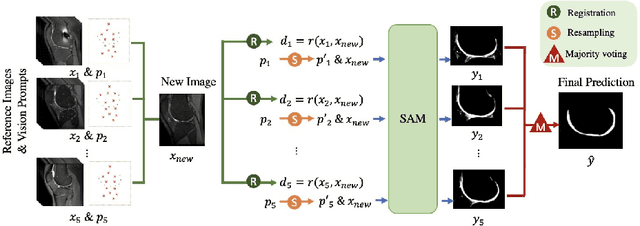
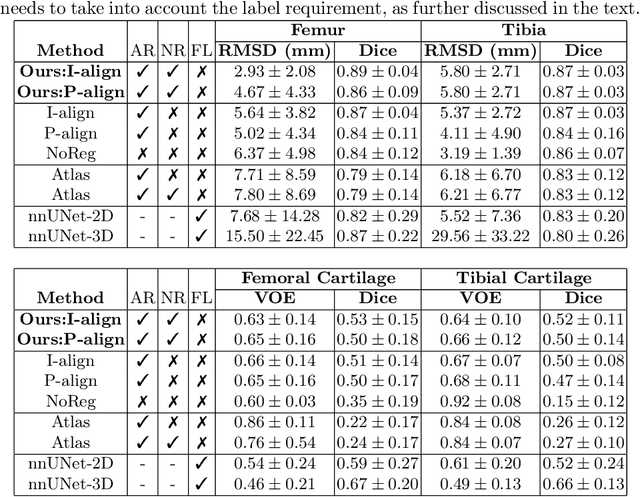
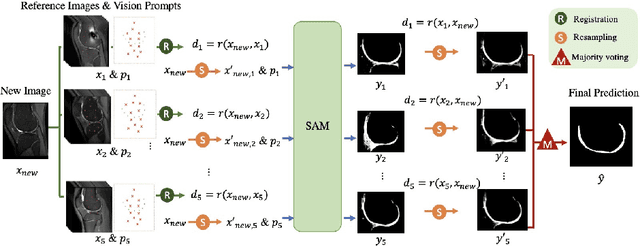
Abstract:The recently proposed Segment Anything Model (SAM) is a general tool for image segmentation, but it requires additional adaptation and careful fine-tuning for medical image segmentation, especially for small, irregularly-shaped, and boundary-ambiguous anatomical structures such as the knee cartilage that is of interest in this work. Repaired cartilage, after certain surgical procedures, exhibits imaging patterns unseen to pre-training, posing further challenges for using models like SAM with or without general-purpose fine-tuning. To address this, we propose a novel registration-based prompt engineering framework for medical image segmentation using SAM. This approach utilises established image registration algorithms to align the new image (to-be-segmented) and a small number of reference images, without requiring segmentation labels. The spatial transformations generated by registration align either the new image or pre-defined point-based prompts, before using them as input to SAM. This strategy, requiring as few as five reference images with defined point prompts, effectively prompts SAM for inference on new images, without needing any segmentation labels. Evaluation of MR images from patients who received cartilage stem cell therapy yielded Dice scores of 0.89, 0.87, 0.53, and 0.52 for segmenting femur, tibia, femoral- and tibial cartilages, respectively. This outperforms atlas-based label fusion and is comparable to supervised nnUNet, an upper-bound fair baseline in this application, both of which require full segmentation labels for reference samples. The codes are available at: https://github.com/chrissyinreallife/KneeSegmentWithSAM.git
Biomechanics-informed Non-rigid Medical Image Registration and its Inverse Material Property Estimation with Linear and Nonlinear Elasticity
Jul 03, 2024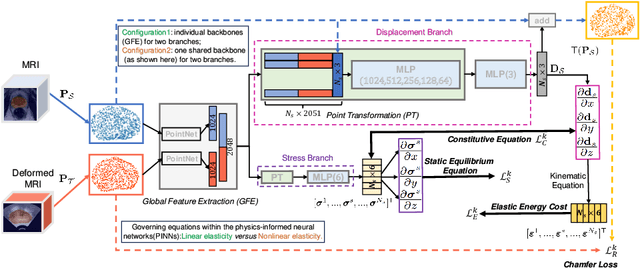



Abstract:This paper investigates both biomechanical-constrained non-rigid medical image registrations and accurate identifications of material properties for soft tissues, using physics-informed neural networks (PINNs). The complex nonlinear elasticity theory is leveraged to formally establish the partial differential equations (PDEs) representing physics laws of biomechanical constraints that need to be satisfied, with which registration and identification tasks are treated as forward (i.e., data-driven solutions of PDEs) and inverse (i.e., parameter estimation) problems under PINNs respectively. Two net configurations (i.e., Cfg1 and Cfg2) have also been compared for both linear and nonlinear physics model. Two sets of experiments have been conducted, using pairs of undeformed and deformed MR images from clinical cases of prostate cancer biopsy. Our contributions are summarised as follows. 1) We developed a learning-based biomechanical-constrained non-rigid registration algorithm using PINNs, where linear elasticity is generalised to the nonlinear version. 2) We demonstrated extensively that nonlinear elasticity shows no statistical significance against linear models in computing point-wise displacement vectors but their respective benefits may depend on specific patients, with finite-element (FE) computed ground-truth. 3) We formulated and solved the inverse parameter estimation problem, under the joint optimisation scheme of registration and parameter identification using PINNs, whose solutions can be accurately found by locating saddle points.
Competing for pixels: a self-play algorithm for weakly-supervised segmentation
May 26, 2024Abstract:Weakly-supervised segmentation (WSS) methods, reliant on image-level labels indicating object presence, lack explicit correspondence between labels and regions of interest (ROIs), posing a significant challenge. Despite this, WSS methods have attracted attention due to their much lower annotation costs compared to fully-supervised segmentation. Leveraging reinforcement learning (RL) self-play, we propose a novel WSS method that gamifies image segmentation of a ROI. We formulate segmentation as a competition between two agents that compete to select ROI-containing patches until exhaustion of all such patches. The score at each time-step, used to compute the reward for agent training, represents likelihood of object presence within the selection, determined by an object presence detector pre-trained using only image-level binary classification labels of object presence. Additionally, we propose a game termination condition that can be called by either side upon exhaustion of all ROI-containing patches, followed by the selection of a final patch from each. Upon termination, the agent is incentivised if ROI-containing patches are exhausted or disincentivised if an ROI-containing patch is found by the competitor. This competitive setup ensures minimisation of over- or under-segmentation, a common problem with WSS methods. Extensive experimentation across four datasets demonstrates significant performance improvements over recent state-of-the-art methods. Code: https://github.com/s-sd/spurl/tree/main/wss
Weakly supervised localisation of prostate cancer using reinforcement learning for bi-parametric MR images
Feb 21, 2024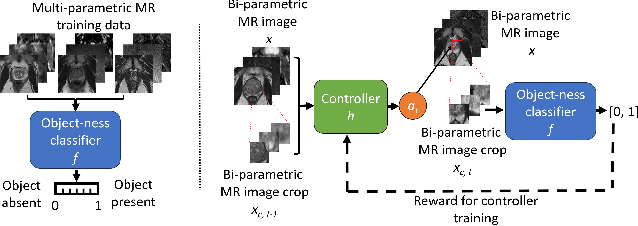

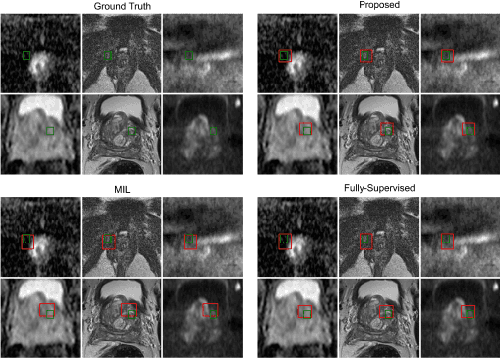
Abstract:In this paper we propose a reinforcement learning based weakly supervised system for localisation. We train a controller function to localise regions of interest within an image by introducing a novel reward definition that utilises non-binarised classification probability, generated by a pre-trained binary classifier which classifies object presence in images or image crops. The object-presence classifier may then inform the controller of its localisation quality by quantifying the likelihood of the image containing an object. Such an approach allows us to minimize any potential labelling or human bias propagated via human labelling for fully supervised localisation. We evaluate our proposed approach for a task of cancerous lesion localisation on a large dataset of real clinical bi-parametric MR images of the prostate. Comparisons to the commonly used multiple-instance learning weakly supervised localisation and to a fully supervised baseline show that our proposed method outperforms the multi-instance learning and performs comparably to fully-supervised learning, using only image-level classification labels for training.
Semi-weakly-supervised neural network training for medical image registration
Feb 16, 2024



Abstract:For training registration networks, weak supervision from segmented corresponding regions-of-interest (ROIs) have been proven effective for (a) supplementing unsupervised methods, and (b) being used independently in registration tasks in which unsupervised losses are unavailable or ineffective. This correspondence-informing supervision entails cost in annotation that requires significant specialised effort. This paper describes a semi-weakly-supervised registration pipeline that improves the model performance, when only a small corresponding-ROI-labelled dataset is available, by exploiting unlabelled image pairs. We examine two types of augmentation methods by perturbation on network weights and image resampling, such that consistency-based unsupervised losses can be applied on unlabelled data. The novel WarpDDF and RegCut approaches are proposed to allow commutative perturbation between an image pair and the predicted spatial transformation (i.e. respective input and output of registration networks), distinct from existing perturbation methods for classification or segmentation. Experiments using 589 male pelvic MR images, labelled with eight anatomical ROIs, show the improvement in registration performance and the ablated contributions from the individual strategies. Furthermore, this study attempts to construct one of the first computational atlases for pelvic structures, enabled by registering inter-subject MRs, and quantifies the significant differences due to the proposed semi-weak supervision with a discussion on the potential clinical use of example atlas-derived statistics.
 Add to Chrome
Add to Chrome Add to Firefox
Add to Firefox Add to Edge
Add to Edge